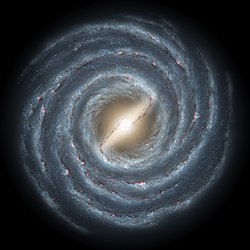Ursa-Major-II-Zwerggalaxie
| Galaxie Ursa-Major-II-Zwerggalaxie[1] | |
|---|---|
| AladinLite | |
| Sternbild | Großer Bär |
| Position Äquinoktium: J2000.0, Epoche: J2000.0 | |
| Rektaszension | 08h 5m 30,0s[2] |
| Deklination | +63° 07′ 48″ [2] |
| Erscheinungsbild | |
| Morphologischer Typ | dSph [2] |
| Helligkeit (visuell) | (14,3 ± 0,5) mag |
| Winkelausdehnung | (32 ± 2)′ [3] |
| Physikalische Daten | |
| Zugehörigkeit | Lokale Gruppe |
| Radialgeschwindigkeit | 116 km/s [2] |
| Entfernung | (98.000 ± 16.000) Lj / (30.000 ± 5.000) pc [2] |
| Geschichte | |
| Entdeckungsdatum | 2006[2] |
| Katalogbezeichnungen | |
Ursa Major II (kurz auch UMa II) ist eine spheroidale Zwerggalaxie (dSph) im Sternbild des Großen Bären und wurde 2006 nach Analyse der Aufnahmen der Durchmusterung des Sloan Digital Sky Survey entdeckt[2].
Eigenschaften
Die Galaxie ist näherungsweise 30 kpc von unserem Sonnensystem entfernt und bewegt sich auf dieses mit einer Geschwindigkeit von etwa 116 km/s zu.[4] Sie hat aufgrund ihrer spheroidalen Eigenschaft in etwa ein elliptisches Achsenverhältnis von 2:1 mit einem Halblichtradius von lediglich etwa 140 pc.[3] UMa II ist damit einer der kleinsten und lichtschwächsten Trabanten unserer Milchstraße (nur Com, Segue 1, Segue 2, Bootes II und Willman 1 sind lichtschwächer).[3]
Die integrale Helligkeit der Zwerggalaxie gleicht in etwa dem 4000-fachen der Sonne, was einer absoluten Helligkeit von −4,2M entspricht.[2] Dies ist deutlich weniger als die Leuchtkraft der meisten Kugelsternhaufen. UMa II ist selbst lichtschwächer als manche Einzelsterne wie beispielsweise Canopus im Sternbild Kiel des Schiffs. Vergleichbar ist sie in der Leuchtkraft mit Bellatrix im Sternbild Orion.
Andererseits besitzt die Galaxie eine Masse von 5 Millionen Sonnenmassen was einem Masse-Leuchtkraft-Verhältnis von ungefähr 2000 gleichkommt[4], welches die Galaxie zu einem extrem stark von dunkler Materie dominierten Objekt machen würde. Dies könnte sich aber auch als eine Fehleinschätzung herausstellen, falls sich die Zwerggalaxie möglicherweise nicht mehr im virialen Gleichgewicht befindet. Dass sie bereits durch die auf sie wirkenden Gezeitenkräfte gestört wird, ist in ihrer ansatzweisen Irregularität erkennbar.[2]
Die Sternpopulation von UMA II setzt sich hauptsächlich aus alten Sternen zusammen, die vor mindestens 10 Milliarden Jahren entstanden sind.[2] Die Metallizität dieser Population erweist sich äußerst metallarm mit [Fe/H] ≈ −2,44 ± 0,06. Die Sonne besitzt etwa 300 mal soviel schwere Elemente.[5] Damit gehören die Sterne dieser Galaxie zu den ersten Sternen überhaupt, die im Kosmos entstanden. Aktuell entstehen in der Ursa-Majoris-II-Zwerggalaxie keine Sterne mehr, auch konnte kein neutrales Wasserstoffgas in der Galaxie festgestellt werden. Die obere der Nachweisgrenze beliefe sich derzeit dafür auf lediglich 562 Sonnenmassen.[6]
Weiteres
- Liste der Satellitengalaxien der Milchstraße
- Liste der Galaxien der Lokalen Gruppe
Einzelnachweise
- ↑ SIMBAD Astronomical Database. In: Results for Ursa Major II. Abgerufen am 19. November 2011.
- ↑ a b c d e f g h i Zucker, D. B.; Belokurov, V.; Evans, N. W.; Kleyna, J. T.; Irwin, M. J.; Wilkinson, M. I.; Fellhauer, M.; Bramich, D. M. et al.: A Curious Milky Way Satellite in Ursa Major. In: Astrophysical Journal. 650: L41, 2006. doi:10.1086/508628.
- ↑ a b c Martin, N. F.; De Jong, J. T. A.; Rix, H. W.: A Comprehensive Maximum Likelihood Analysis of the Structural Properties of Faint Milky Way Satellites. In: The Astrophysical Journal. 684(2): 1075, 2008. doi:10.1086/590336.
- ↑ a b Simon, J. D.; Geha, M.: The Kinematics of the Ultra‐faint Milky Way Satellites: Solving the Missing Satellite Problem. In: The Astrophysical Journal. 670: 313, 2007. doi:10.1086/521816.
- ↑ Kirby, E. N.; Simon, J. D.; Geha, M.; Guhathakurta, P.; Frebel, A.: Uncovering Extremely Metal-Poor Stars in the Milky Way's Ultrafaint Dwarf Spheroidal Satellite Galaxies. In: The Astrophysical Journal. 685: L43, 2008. doi:10.1086/592432.
- ↑ Grcevich, J.; Putman, M. E.: H I in Local Group Dwarf Galaxies and Stripping by the Galactic Halo. In: The Astrophysical Journal. 696: 385, 2009. doi:10.1088/0004-637X/696/1/385.
Weblinks
Auf dieser Seite verwendete Medien
Caption from NASA: Like early explorers mapping the continents of our globe, astronomers are busy charting the spiral structure of our galaxy, the Milky Way. Using infrared images from NASA's Spitzer Space Telescope, scientists have discovered that the Milky Way's elegant spiral structure is dominated by just two arms wrapping off the ends of a central bar of stars. Previously, our galaxy was thought to possess four major arms.
This artist's concept illustrates the new view of the Milky Way, along with other findings presented at the 212th American Astronomical Society meeting in St. Louis, Mo. The galaxy's two major arms (Scutum-Centaurus and Perseus) can be seen attached to the ends of a thick central bar, while the two now-demoted minor arms (Norma and Sagittarius) are less distinct and located between the major arms. The major arms consist of the highest densities of both young and old stars; the minor arms are primarily filled with gas and pockets of star-forming activity.
The artist's concept also includes a new spiral arm, called the "Far-3 kiloparsec arm," discovered via a radio-telescope survey of gas in the Milky Way. This arm is shorter than the two major arms and lies along the bar of the galaxy.
Our sun lies near a small, partial arm called the Orion Arm, or Orion Spur, located between the Sagittarius and Perseus arms.



